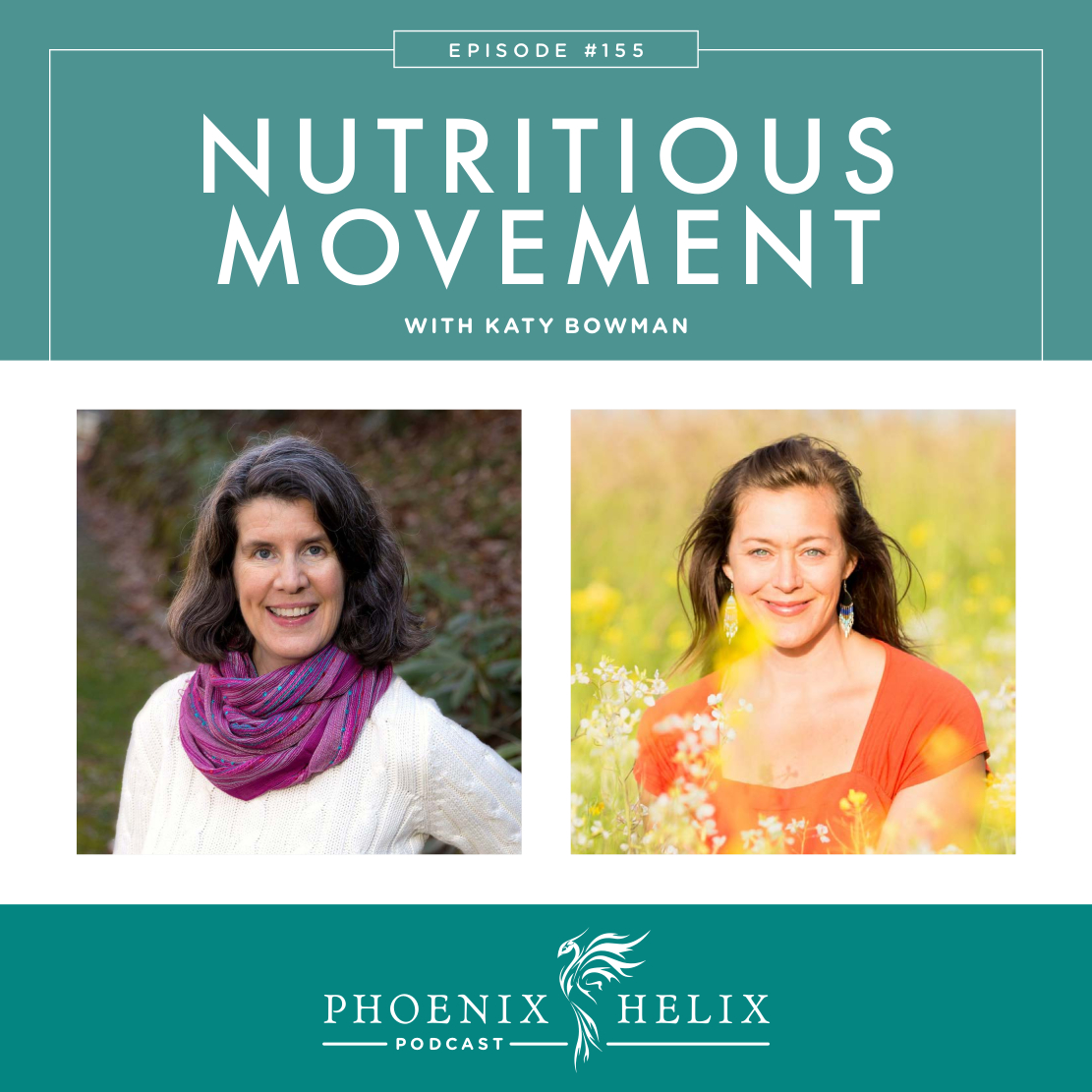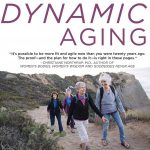
What Is Nutritious Movement?
We talk a lot about nutrient density and diversity on this podcast. Every food has a unique nutrient profile, and when we get in food ruts and eat the same thing every day, our nutrition suffers. The same thing happens with movement. Modern life limits the way we move our bodies, but then chronic illness can limit it even more. This creates a vicious cycle. How do we break free and expand our ability to move, enhancing our health at the same time? My guest today is Katy Bowman, a biomechanist, teacher, speaker, and author. She’s written 8 books, including the bestselling Move Your DNA, which has been translated into more than a dozen languages.
Listen to the Show
- Subscribe to my podcast through your favorite podcast app: iTunes, Stitcher, Google, TuneIn, Spotify, Amazon, etc.
- You can also listen to the episode right here through the player below, and if you subscribe to my newsletter you’ll get notified of future episodes.
Podcast: Play in new window | Download
Show Notes
- Intro (0:00)
- Thank You to Our Podcast Sponsor: ShopAIP (2:03)
- It’s summertime, which makes me think of grilling season and condiments. KC Natural is an AIP-friendly brand that has created substitutes for many of your favorites. They sell salad dressings, barbecue sauces, spice rubs, and AIP versions of both ketchup and mustard. You can find all of these items and more at ShopAIP.
- ShopAIP is an online store dedicated to the Paleo Autoimmune Protocol. With hundreds of items for the elimination phase of the AIP, and new products labeled by reintroduction category as well. You can find protein bars, sauces and condiments, AIP-friendly spices, cooking and baking ingredients, delicious snacks, non-toxic skincare, and more.
- If you’re a first-time customer, use the code PHOENIX for 10% off your order. Purchase here.
- Meet Katy (3:05)
- Katy Bowman is a movement and health expert. She’s a biomechanist, teacher, speaker, and author. She’s written 8 books, including the bestselling Move Your DNA, which has been translated into more than a dozen languages.
- Biomechanics is the study of physical forces on living systems. Katy’s focus is the human body and how movement (and non-movement) affect health and function.
- She herself comes from a sedentary background and was a bookworm as a child. She didn’t start exercising until she was a young adult and felt so much better that it inspired her career.
- Her focus is helping people feel better through movement. In the scientific literature, movement is recommended for almost every health condition, to either prevent or treat symptoms.
- What Is Nutritious Movement? (6:45)
- Just as a dietitian looks deeply at a person’s diet to see what nutrients might be missing, Katy looks at how a person moves throughout the day to see what movements are missing.
- People often feel pain or dysfunction in a specific point on their body, but it’s not an isolated problem. The solution lies in looking at the body as a whole. Where is there a movement deficiency (similar to a nutrient deficiency)?
- Nutritious movement isn’t a prescribed set of exercises to do at a certain time of day, but rather a way of integrating more variety of movement throughout the day.
- Nutritious movement also looks at how the human body was designed to move, and how different cultures support or inhibit that natural design. In North America, we are the most sedentary we have ever been in human history.
- Resource Video: Nutritious Movement Overview.
- Starting the Day with Nutritious Movement From Bed (12:25)
- Movement is simply a change of position, and we don’t change our positions that often. So, we can add nutritious movement as soon as we wake up, while we’re still in bed.
- Katy recommends “bed angels”. Do a snow angel movement in bed, spreading your arms out to the side and overhead and back down again. Repeat that a few times. We spend most of the day with our arms by our side. Any opportunity to put our arms in a different position helps fill this movement deficiency.
- You can also do angel movements during the day – lying on the floor or standing with your back against a wall. And whenever you walk through a doorway, see that as a reminder to reach up and touch the top.
- Other nutritious movements from bed: Stretch your hands. Rotate your wrists. Bring your knees to your chest. Choose any movement(s) that you don’t usually do.
- Posture and Alignment (14:50)
- Nutritious movement also applies to the times that we are still. We repeat postures the same way we repeat movements, and we want to diversify both.
- Most of us have an unhealthy “natural” posture. We may jut one hip out to the side, hold our head forward, splay our feet, round our shoulders, or hold our shoulders tensely up by our ears. Becoming aware of your posture and making adjustments can have a profound impact on your health.
- Katy recommends doing an alignment check in the shower or when you’re facing a mirror in the morning. Are your feet pointing forward? Are your hips centered over your heels? Are your shoulders back and relaxed? Is your head aligned with your spine? Adjust accordingly. Then find spots in your day that can serve as reminders to check your alignment again. Maybe whenever you’re waiting in line, or standing in front of a sink.
- Resource: Assess Your Stance.
- How Clothing Affects Movement (17:19)
- In our sedentary culture, we have separate clothes for exercise vs. daily life. Often, our “regular” clothing restricts movement, and we’ve accepted that as normal. If you want to build more nutritious movement into your day, you need to wear clothes that allow for that. It doesn’t mean you need to look like you’re going to the gym, but you can choose styles and sizes that allow a wider range of movement.
- The Downside of Perseverance (20:56)
- Human beings are excellent at adapting and powering through, but there’s a downside. Adapting around physical pain and/or movement challenges allows those problems to persist and often creates new problems. For example, if your legs struggle with stairs, you may use the railing to pull you up the stairs. That may cause shoulder trouble down the line.
- Nutritious movement has the goal of restoring movement – noticing where it’s limited and assessing what whole-body movements can potentially restore strength and function.
- Baby Steps to Getting Up the Stairs (23:25)
- One of Katy’s goals for every client is to be able to navigate 3 steps of stairs if at all possible, because this greatly expands opportunities in life.
- With autoimmune disease, stairs can be challenging for multiple reasons. When Katy works with people 1:1, she assesses and makes recommendations around those unique challenges, but here are 4 baby steps she recommends to everyone.
- Baby Step 1: Notice the shape of the body required to navigate stairs. The ankles need to flex and extend. The knees and hips need to be able to bend. You can work on these movements in bed. Katy starts all of her clients with this Strap Stretch.
- Baby Step 2: Stand in front of the stairs and gently lift your leg and place your foot fully on the first step. How does that movement feel – where is it easy and where is it hard? Take your foot off the step, and then do the same with your opposite foot.
- Baby Step 3: What is the rest of your body doing when you go up the stairs? Are you aligned or leaning forward? If you’re using the rail for leverage, can you start to lighten your grip and use the railing for balance, allowing more of the strength to come from your legs?
- Baby Step 4: Which foot do you usually place on the stairs first? If you reverse that and begin with the other leg, how does that feel? Is one leg weaker than the other? Can one leg support more of that motion for now, and can you focus on improving the strength of the other leg through movement exercises?
- Movement Is For Every Body (28:08)
- Even if stairs aren’t an option, no matter your level of ability/disability, there are ways to incorporate more movement into your life and feel the benefit.
- With autoimmune disease, we often disassociate from our bodies. This is a process of gently reinhabiting your body and expanding its potential.
- Thank You to Our Podcast Sponsor – Paleo on the Go (30:05)
- A frozen meal delivery service, 100% of their menu is compliant with the elimination phase of the paleo autoimmune protocol (AIP). They have over 5o items, including entrees, side dishes, broth, AIP-friendly bacon, and desserts.
- Use the code PHOENIX for 10% off your first order.
- Katy’s Furniture-Free Home (31:36)
- She does have some furniture. What she doesn’t have is traditional seating – no chairs – no couches. Instead she has cushions, low ottomans, and the floor.
- Sometimes sitting in a different way can be the easiest way to get more nutritious movement in your life.
- Our environment directly influences how much we more vs. don’t move. Chairs are an integral part of a sedentary lifestyle, and when people go to a physical therapist, they’re often trying to undo the damage that chairs have done. If you remove chairs (or change the variety of seating in your home and office), your body will naturally move, stretch, and strengthen throughout the day.
- Baby Step 1: Put an ottoman next to your favorite chair, and alternate your time between the chair and ottoman. Ottomans don’t have backs, which means you’ll need to support your back yourself, building core strength.
- Baby Step 2: Experiment with getting down on the floor. Where is it uncomfortable? Can you use pillows or rolled towels as bolsters to make it more comfortable? Don’t remove entire categories of movement from your life (like getting up and down from the floor). Often they can be modified and become possible again.
- Resource: Video Tour of Katy’s Home.
- Gardening is a Nutritious Movement Superfood (40:14)
- In addition to movement, community and nature are nutrients our bodies need as well. Gardening combines all three.
- Gardening involves both fine motor movements and full-body movement. There’s the relationship with the plants, and in community gardens, there’s relationship with other people.
- Gardening can be adapted to your physical needs. Accessible gardens can be created for people in wheelchairs. Raised beds help if you can’t squat or bend without pain. Patio gardens can bring a lot of joy. Even an herb garden in the kitchen is beneficial.
- In research, they call this horticultural therapy and it’s shown to help with chronic pain.
- Technology and Nutritious Movement (43:42)
- Technology brings many benefits to our lives, but also encourages poor posture and less movement.
- Tip 1: Be aware of your head position when you’re using technology and adjust it into a healthier alignment. (Resource: How to Avoid Tech-Neck.)
- Tip 2: Even taking small breaks from a sedentary posture benefits cardiovascular health. Use an app that reminds you to get up and move around. You can set the timing of that reminder. (Resources: Time Out for computers, Stand Up for iPhone, Work Break for Android.)
- Tip 3: Our eyes aren’t meant to focus only on short distances. Different muscles are used to focus close vs. far away. Take breaks from the computer and go to a window or step outside, and focus on things at a distance.
- Tip 4: Try to combine movement with technology where you can. Take walking phone calls. Set up props by your computer where you can gently stretch your calves. When there’s an audio education option instead of reading, listen and move while you learn.
- Tip 5: You may also look at your technology use overall to see if you’d like to set limits or take sabbaticals. (Resource: What Is a Digital Detox?)
- Why Katy Loves Walking (50:40)
- Human beings historically walked at least 3 miles every day, and this activity supports overall health.
- However, modern life has changed not only how much we walk, but also our walking gait. Gait is like an accent. You can often recognize families who walk together, because we learn to walk by copying those around us.
- Nutritious walking isn’t about taking more steps, it’s about moving more parts of your body, more freely, in the steps that you take.
- First, assess your stance. Stand, relax, close your eyes. Are your feet facing forward or are they splayed out or inward? Is one foot carrying more weight than the other. Is your weight balanced between the front and back of your feet? Can you align your body and equalize that weight?
- Next, walk slowly around your home. We take more steps in our home and office than we do while exercising. If we become more aware of those steps, that can have a more powerful impact. As you walk, are some joints and muscles tighter than others? Can you incorporate some gentle stretches for those muscles during the day, so they can move more freely as you walk?
- Resource: 13 Ways to Make Your Walk More Nutritious.
- Nutritious Movement Resources (56:35)
- Book: Dynamic Aging.
- DVD: Daily Movement Multivitamin.
- Work with someone 1:1: Trained Practitioner Directory.
- Website: Nutritious Movement.
- Outro
- You can connect with Katy Bowman through her website: Nutritious Movement. There, you’ll find all of her books, DVD’s, and online classes. She also offers free information through her blog, podcast, and newsletter.
- Eileen (your podcast host) is the author of multiple books, written to help people thrive with autoimmune disease. Learn more on the Books Page.
- If you like this podcast, follow or subscribe through your favorite podcast app. You can also subscribe to Eileen’s biweekly newsletter.
- Check out the entire archive of podcast episodes.
You May Also Be Interested In
Spreading the Word
If you like the podcast, please leave a positive review in iTunes. It would mean the world to me, and also helps others find the podcast. Here are some quick instructions using your iPhone:
- If you are already subscribed to my podcast: (1) Click the purple podcast icon. (2) At the bottom of the screen, click Library. (3) At the top of the screen, click Shows. (4) Click the Phoenix Helix podcast image. (5) Scroll down the page, and you’ll see Ratings and Reviews. Scroll down a little bit more and click on Write a Review. This will bring up the review screen. Tap 5 stars (if you love the podcast), and then click in the title box, and it will bring up the keyboard. Enter a title and short review. (6) Click Send in the upper right corner. (7) Thank you! Positive reviews give the podcast a higher search ranking in iTunes, helping people find it and letting them know it’s a quality podcast and worth their time to listen.
- If you haven’t subscribed to my podcast: (1) Click the purple podcast icon. (2) In the lower right corner, click the magnifying class. (3) Type Phoenix Helix in the search box. (4) Click the podcast cover in the Show list. (5) If you’d like to subscribe, click the + sign at the top of the screen. (6) To write a review, scroll down the page, and you’ll see Ratings and Reviews. Scroll down a little bit more and click on Write a Review. This will bring up the review screen. Tap 5 stars (if you love the podcast), and then click in the title box, and it will bring up the keyboard. Enter a title and short review. (7) Click Send in the upper right corner. (8) Thank you! Positive reviews give the podcast a higher search ranking in iTunes, helping people find it and letting them know it’s a quality podcast and worth their time to listen.







